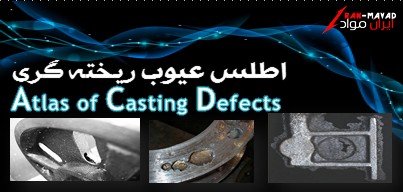دانلود کتاب،مقاله،جزوه و نرم افزار مهندسی مواد
کلیه منابع مورد نیاز دانشجویان و مهندسین مواد (متالورژی ، سرامیک ، جوش ، خوردگی ، نانو و بایومواد)دانلود کتاب،مقاله،جزوه و نرم افزار مهندسی مواد
کلیه منابع مورد نیاز دانشجویان و مهندسین مواد (متالورژی ، سرامیک ، جوش ، خوردگی ، نانو و بایومواد)مقدمه ای بر ریخته گری تحت فشار و عیوب رایج در آن
Introduction Of High Pressure Die-Casting
And Common Defects In Die-Casting
مقدمه ای بر ریخته گری تحت فشار و عیوب رایج در آن
ABSTRACT
Die casting is a manufacturing process that can produce geometrically complex metal parts through the use of reusable molds, called dies. The die casting process involves the use of a furnace, metal, die casting machine, and die. The metal, typically a non-ferrous alloy such as aluminum or zinc, is melted in the furnace and then injected into the dies in the die casting machine. There are two main types of die casting machines - hot chamber machines (used for alloys with low melting temperatures, such as zinc) and cold chamber machines (used for alloys with high melting temperatures, such as aluminum). The differences between these machines will be detailed in the sections on equipment and tooling. However, in both machines, after the molten metal is injected into the dies, it rapidly cools and solidifies into the final part, called the casting. The steps in this process are described in greater detail in the next section.
![]()
اطلس عیوب ریخته گری
اطلس عیوب ریخته گری

شرح :
اطلس عیوب ریخته گری : ریخته گری قطعات از قدیم الایام بدلیل شرایط متالورژیکی و تکنولوژیکی دجار عیب و نقص های متعددی بوده و مهم ترین وظیفه ریخته گران شناخت ، کنترل و رفع این عیوب بوده است . عیوب ریختهگری مانند تخلخل، غیر یکنواختی، ترک خوردگی و موارد دیگر تحت شرایط عملی در قطعات تولیدی در صنعت بوجود میآیند. یک عیب ممکن است دقیقا منشعب یکی از علل موجود و یا نتیجه ترکیبی از آنها باشد. در برخی موارد حتی علت برخی از عیوب هنوز معلوم نگردیده است. هرگونه عملی برای تقلیل یا حذف عیوب ریختهگری باید تحت شرایط اقتصادی انجام شود تا هزینه تولید در مقابل کیفیت تولید در موازنه قرار گیرد. در این کتاب بطور کامل به انواع عیوب ریخته گری ، دلایل ایجاد و روش های رفع آن پرداخته شده است . کتاب حاضر شامل مباحث زیر می باشد.
ادامه مطلب ...